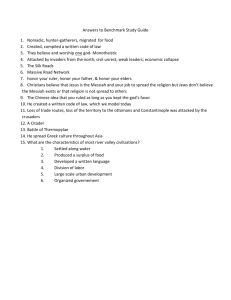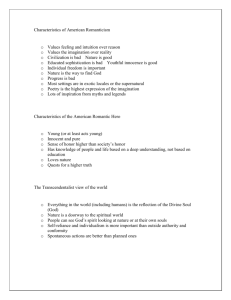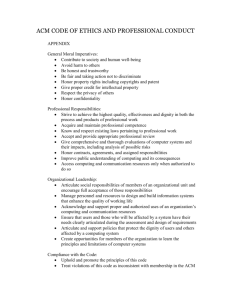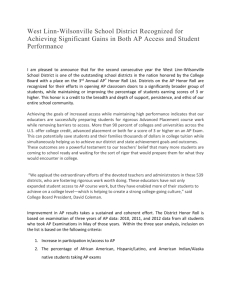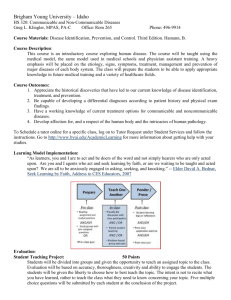Finance 444 – Risk Management - University of South Carolina
advertisement
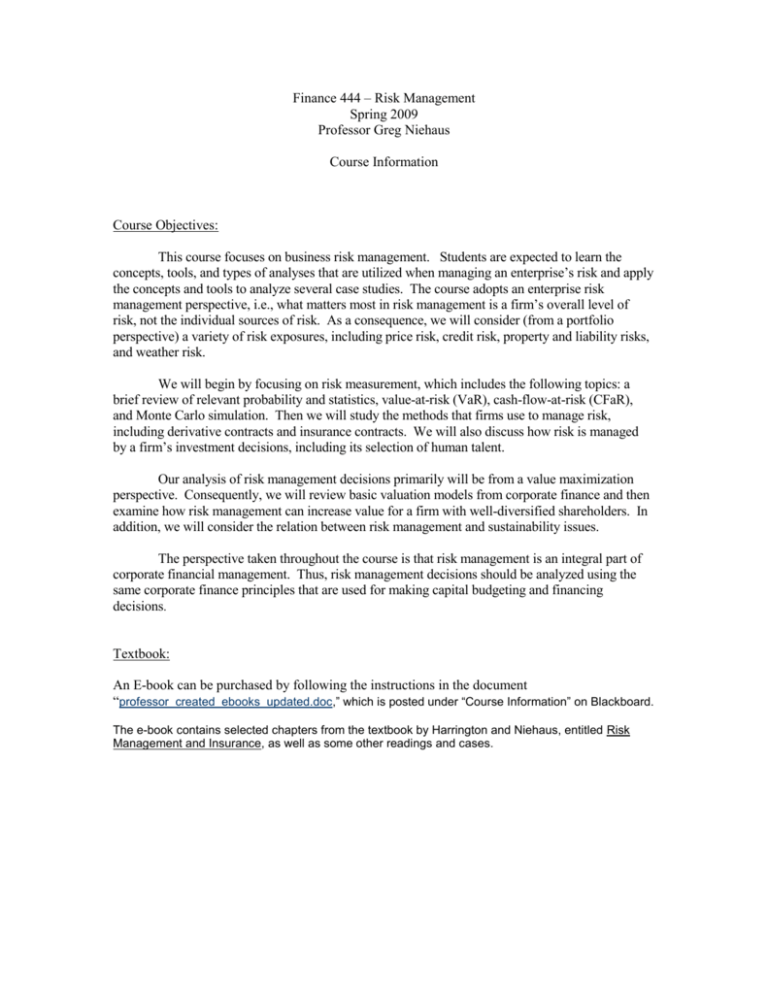
Finance 444 – Risk Management Spring 2009 Professor Greg Niehaus Course Information Course Objectives: This course focuses on business risk management. Students are expected to learn the concepts, tools, and types of analyses that are utilized when managing an enterprise’s risk and apply the concepts and tools to analyze several case studies. The course adopts an enterprise risk management perspective, i.e., what matters most in risk management is a firm’s overall level of risk, not the individual sources of risk. As a consequence, we will consider (from a portfolio perspective) a variety of risk exposures, including price risk, credit risk, property and liability risks, and weather risk. We will begin by focusing on risk measurement, which includes the following topics: a brief review of relevant probability and statistics, value-at-risk (VaR), cash-flow-at-risk (CFaR), and Monte Carlo simulation. Then we will study the methods that firms use to manage risk, including derivative contracts and insurance contracts. We will also discuss how risk is managed by a firm’s investment decisions, including its selection of human talent. Our analysis of risk management decisions primarily will be from a value maximization perspective. Consequently, we will review basic valuation models from corporate finance and then examine how risk management can increase value for a firm with well-diversified shareholders. In addition, we will consider the relation between risk management and sustainability issues. The perspective taken throughout the course is that risk management is an integral part of corporate financial management. Thus, risk management decisions should be analyzed using the same corporate finance principles that are used for making capital budgeting and financing decisions. Textbook: An E-book can be purchased by following the instructions in the document “professor_created_ebooks_updated.doc,” which is posted under “Course Information” on Blackboard. The e-book contains selected chapters from the textbook by Harrington and Niehaus, entitled Risk Management and Insurance, as well as some other readings and cases. Class Schedule: Tuesday Thursday 3:30 - 4:45 3:30 - 4:45 A review session will be scheduled before each exam. Office Hours: (dean’s office on 1st floor) Tuesday Thursday 2:30 - 3:15, 4:45 - 5:30 2:30 - 3:15, 4:45 - 5:30 And also by appointment My schedule is kept by Henrietta Etheredge, please arrange appointments with her by emailing Etheredge@moore.sc.edu My e-mail is gregn@moore.sc.edu Lecture Notes: Lectures typically will include powerpoint presentations. Copies of the slides will be available on blackboard prior to class (hopefully, the night before) Guest Lecturers We likely will have guest lecturers the week after spring break. You will be tested on the material presented during these sessions. Grades: Exam 1 (Feb 12) Exam 2 (Apr 2) Final exam (May 2, 9:00) Contribution to class Homework 20% 25% 30% 5% 20% All exams are cumulative. To encourage you to contribute to class, your grade depends on my subjective assessment of your contribution to class over the semester. You start the semester with a grade for contribution to class equal to 50 percent. You can increase that grade by contributing to class in a positive and consistent manner. You can decrease that grade by detracting from class. Typically, most students will not change their contribution to class grade. Arriving late for class or leaving in the middle of class disrupts other students. Therefore, consistently arriving late will lower your contribution to class grade. Consistently missing class also will lower your contribution to class grade. Homework problems and possibly short writing assignments will be assigned periodically. Late assignments will suffer a 10% penalty per day. The writing assignments will require you to either report on a current issue or think about some issue and present your own analysis. They will be graded on content and writing. Poorly written assignments will be returned and you will be required to rewrite. Some assignments may be group projects related to a case on risk management. University of South Carolina Honor Code It is the responsibility of every student at the University of South Carolina Columbia to adhere steadfastly to truthfulness and to avoid dishonesty, fraud, or deceit of any type in connection with any academic program. Any student who violates this Honor Code or who knowingly assists another to violate this Honor Code shall be subject to discipline. This Honor Code is intended to prohibit all forms of academic dishonesty and should be interpreted broadly to carry out that purpose. The following examples illustrate conduct that violates this Honor Code, but this list is not intended to be an exhaustive compilation of conduct prohibited by the Honor Code: 1. Giving or receiving unauthorized assistance, or attempting to give or receive such assistance, in connection with the performance of any academic work. 2. Unauthorized use of materials or information of any type or the unauthorized use of any electronic or mechanical device in connection with the completion of any academic work. 3. Access to the contents of any test or examination or the purchase, sale, or theft of any test or examination prior to its administration. 4. Use of another person’s work or ideas without proper acknowledgment of source. 5. Intentional misrepresentation by word or action of any situation of fact, or intentional omission of material fact, so as to mislead any person in connection with any academic work (including, without limitation, the scheduling, completion, performance, or submission of any such work). 6. Offering or giving any favor or thing of value for the purpose of influencing improperly a grade or other evaluation of a student in an academic program. 7. Conduct intended to interfere with an instructor’s ability to evaluate accurately a student’s competency or performance in an academic program. Whenever a student is uncertain as to whether conduct would violate this Honor Code, it is the responsibility of the student to seek clarification from the appropriate faculty member or instructor of record prior to engaging in such conduct. Suspected violations of the honor code will be reported to the Office of Academic Integrity. Violations of the honor code will result in disciplinary measures. Specific Learning Outcomes Understand the different interpretations of risk For each interpretation of risk, understand the various measures of risk Be able to calculate various measures of risk for individual risk exposures and portfolios of risk exposures Describe the main characteristics of the risk management process Understand the various methods that businesses use to manage risk Understand the conditions under which business decisions that maximize firm value result in an efficient allocation of resources Describe conditions under which business decisions that maximize firm value may not yield an efficient allocation of resources Understand the factors that limit the extent to which risk can be diversified or traded from one entity to another Understand the factors that determine the price of insurance in a competitive market Understand the types of derivative contracts and how they can be used to reduce risk Understand basic financial valuation models and how risk is incorporated in these models Understand the reasons that diversifiable risk can affect firm value Evaluate circumstances under which risk reduction will increase firm value Understand why non-traditional types of risk transfer contracts are used Understand the various interpretations of a sustainable enterprise and how risk management is related to sustainable enterprise Understand the benefits and costs of using an enterprise risk management approach Apply the tools and concepts learned in the course to cases and new situations Finance 444 – Risk Management Spring 2009 Professor Greg Niehaus Outline 1. INTRODUCTION TO BUSINESS RISK MANAGEMENT Reading: Ch. 1 Ch. 2 Topics: What is risk? Types of risks that businesses face Risk Management Process Overview of risk management methods Objectives of corporate risk management Value maximization Conflicts between societal welfare and value maximization 2. RISK IDENTIFICATION AND MEASUREMENT Reading: Ch. 3 “Theory of Risk Capital in Financial Firms” Topics: Risk identification Probability distributions Expected value, standard deviation Correlation Value at risk Maximum probable loss Frequency and severity of losses 3. DATA ANALYSIS TOOLS USED IN RM Reading: Ch. 26 Topics: Statistical tools to analyze historical data Using the normal distribution Monte Carlo simulation 4. INVESTMENT DECISIONS THAT CHANGE THE PROBABILITY DISTRIBUTION OF CASH FLOWS (LOSS CONTROL) Reading: Ch. 11 Topics: Safety decisions Contract design issues Selection of leaders 5. FINANCING DECISIONS - INSURANCE CONTRACTS Reading: Ch. 4 – Pooling Arrangements and Diversification of Risk Ch. 8 – Insurance Pricing Ch. 10 – Insurability of Risk, Contractual Provisions, & Legal Doctrines Ch. 23 – Commercial Insurance Contracts Topics: Risk pooling Role of insurance companies Insurance pricing Contractual provisions (deductibles, limits, exclusions) Moral hazard Adverse selection Layering coverage Occurrence vs. claims made coverage 6. FINANCING DECISIONS - DERIVATIVE CONTRACTS Reading: Ch. 24 – Hedging with Derivative Contracts American Barrick Resources Case Topics: Forward contracts Futures contracts Option contracts Swap contracts Over-the-counter market for derivatives Exchange traded derivatives Comparison of derivative contracts with insurance contracts 7. HOW DOES RISK REDUCTION AFFECT SHAREHOLDER VALUE Reading: Ch. 20 “Corporate Insurance Strategy: The Case of British Petroleum,” Topics: Valuation models (WACC approach, Flow to equity approach) Effect of risk reduction on the cost of equity capital Effect of risk reduction on expected cash flows to equityholders British Petroleum example 8. TAX, REGULATORY, & ACCOUNTING FACTORS & RISK REDUCTION Reading: Ch. 21 Topics: Effect of progressive tax rates Different tax treatment of insurers and non-insurers Interest tax shields on debt Premium and excise taxes Compulsory insurance laws Excess and surplus lines market Accounting treatment of insurance and derivatives 9. RISK RETENTION/REDUCTION DECISIONS Reading: Ch. 22 American Barrick Resources Case Topics: Firm characteristics affecting risk reduction decisions Bundling exposures 10. NON-TRADITIONAL FINANCING DECISIONS (ALTERNATIVE RISK TRANSFER) Reading: Ch. 25 Topics: Loss sensitive insurance contracts Finite risk contracts Captive insurers Contingent financing arrangements Index linked notes Catastrophe bonds 11. SUSTAINABILITY ISSUES AND RISK MANAGEMENT Reading: 12. Handout “Equator Principles: An Industry Approach to Managing Environmental and Social Risks” ENTERPRISE RISK MANAGEMENT Reading: Ch. 27, United Grain Growers Case Topics: Enterprise risk management Chief risk officer Advantages and disadvantages of bundling multiple exposures United Grain Growers Case

